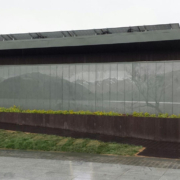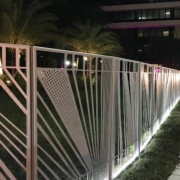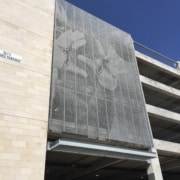El Primer Monumento a las Víctimas de Linchamientos de la Nación
La Iniciativa por la Igualdad de Justicia está construyendo un monumento nacional a las víctimas de linchamientos en Montgomery, Alabama, cuya inauguración está prevista para 2018. Este proyecto conmemorativo relacionado con la historia de Estados Unidos de terror racial y linchamiento se convertirá en el más ambicioso de la nación sobre este tema. Una estructura clásica fue diseñada para el monumento, consistiendo en 805 columnas-una para cada condado donde Eji documentó linchamientos raciales del terror. Cuando los visitantes entran en el Memorial, el suelo cae y la percepción cambia cuando los visitantes se dan cuenta de que las columnas que parecían estar sosteniendo la estructura son en realidad monumentos suspendidos de arriba, que evocan los linchamientos que tuvieron lugar en la plaza pública. Más de 4.000 nombres de las víctimas de linchamientos serán inscritos en estos monumentos.
Además de las 805 columnas conmemorativas, hay 805 «módulos del banco de memoria» idénticos que están situados temporalmente en el paisaje que rodea el monumento y que se trasladarán a los condados de todo el país donde tuvieron lugar los linchamientos. En total son 1.610 módulos con más de 8.000 nombres.
Entrevistamos a Eric Simonsen, nuestro Vicepresidente de Gestión de Proyectos, para hablar de este proyecto con más detalle.
____________________________________________________________________________________
Productos y materiales
Paneles de sofito/techo: Paneles Flatlock de grafito elZinc 20ga
Monumentos conmemorativos fabricados a medida: Acero de intemperie A606, calibre 11
Desafíos de diseño
Paneles de sofito/techo: «El proyecto presentaba varios retos de ‘diseño’. Tuvimos que modificar nuestro sistema estándar de paneles planos para superar los retos estéticos, estructurales y de instalación. Estéticamente, la intención del diseño era una superficie completamente plana. La base del diseño era un panel estilo «s-lock» que habría proporcionado la alineación superficial de los paneles que deseaban, pero no habría cumplido los requisitos de carga estructural. Nuestro panel flatlock estándar tiene una superficie escalonada en la que los paneles se solapan y entrelazan, pero son las juntas entrelazadas las que dan al sistema la resistencia necesaria para cumplir las cargas de diseño. Así que añadimos un perfil escalonado al panel para que tuvieran una alineación de superficie enrasada pero mantuvieran la resistencia que necesitábamos. La instalación del sistema de paneles también es atípica para nuestro sistema de paneles flatlock porque se instala sobre un sistema de entramado de rejilla abierta. Sin un sustrato sólido, los puntos de fijación de los paneles son limitados, por lo que fue necesaria una gran coordinación entre todos los gremios implicados a lo largo del proceso de dibujo en taller.»
Monumentos fabricados a medida:
«El mayor reto de diseño de los módulos conmemorativos fue/es el manejo de los datos. Hay un total de 1.610 módulos únicos: 805 columnas conmemorativas y 805 módulos de bancos de memoria, y hay más de 8.000 nombres de víctimas inscritos en esos módulos. La selección del tipo de letra, la disposición y el espaciado del tipo de letra, el proceso de fabricación para inscribir los nombres, el proceso de revisión para asegurarnos de que los nombres se transferían con precisión desde el diseñador gráfico hasta nosotros para su fabricación, y el seguimiento de todo ello desde el diseño hasta la finalización de la fabricación es una tarea de enormes proporciones de la que estamos orgullosos de formar parte.»
Debatir el proceso de desarrollo
«El proceso de desarrollo de los monumentos conmemorativos A606 fabricados a medida requirió muchas rondas de presentación de muestras para determinar el producto y el proceso exactos que querían los diseñadores y el cliente. Experimentamos con distintos métodos para inscribir el texto: grabado, texto totalmente cortado, texto con incrustación de color, texto con soporte de contraste y, finalmente, nos decidimos por el texto totalmente cortado con la sombra del interior del módulo como contraste para la legibilidad. Utilizamos diversas técnicas de fabricación para cortar el texto y dar a los diseñadores y clientes opciones de estilo y tamaño de fuente, analizando al mismo tiempo la eficacia de la producción para mantener el presupuesto del proyecto. También enviamos varias muestras de acabados predesgastados utilizando distintos métodos de predesgaste para conseguir el aspecto deseado para la inauguración del proyecto, permitiendo al mismo tiempo que el metal se desgastara de forma natural in situ.»
Detalles de fabricación a medida
«Estamos utilizando una célula de soldadura robotizada totalmente automatizada para producir los módulos. Los componentes individuales de cada módulo se cortan con láser en un centro de procesamiento láser CNC y luego se sueldan para crear los módulos utilizando la célula de soldadura robotizada. Todo el proceso requiere un delicado equilibrio entre hábiles fabricantes, programadores y gestores, junto con la avanzada tecnología del proceso de producción automatizado.»
Comentarios
«Personalmente puedo decir que, dado el actual clima político y sociocultural de nuestro país, estoy orgulloso de formar parte de un proyecto que trabaja para curar las heridas del pasado de nuestro país y que trabaja para unificarnos como personas en lugar de dividirnos».






